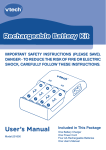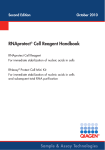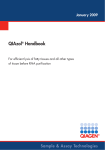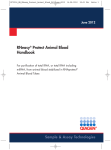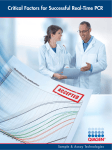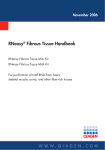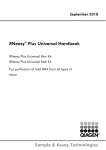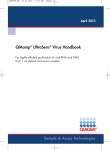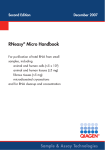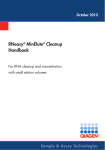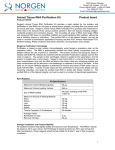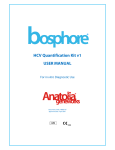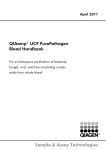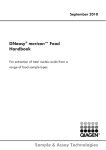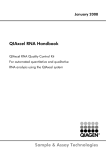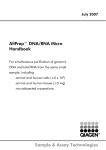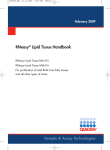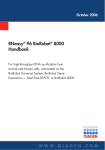Download RNeasy® Protect Saliva Mini Handbook
Transcript
September 2010 RNeasy® Protect Saliva Mini Handbook For immediate stabilization of total RNA in saliva and subsequent RNA purification W W W. Q I A G E N . C O M Trademarks: QIAGEN®, MinElute®, Omniscript®, Quantiscript®, QuantiTect®, RNAprotect®, RNeasy®, Sensiscript® (QIAGEN Group); ABI PRISM®, Applied Biosystems® (Applera Corporation or its subsidiaries); LightCycler® (Roche Group); PAXgene™ (PreAnalytiX GmbH); SYBR® (Molecular Probes, Inc.). “RNAlater®” is a trademark of AMBION, Inc., Austin, Texas and is covered by various U.S. and foreign patents. The PAXgene Blood RNA Kit (cat. nos. 762164 and 762174) is for in vitro diagnostic use. Not available in all countries. Purchase of QIAGEN products for PCR containing HotStarTaq DNA Polymerase is accompanied by a limited license to use them in the polymerase chain reaction (PCR) process for research and development activities in conjunction with a thermal cycler whose use in the automated performance of the PCR process is covered by the up-front license fee, either by payment to Applied Biosystems or as purchased, i.e. an authorized thermal cycler. The PCR process is covered by the foreign counterparts of U.S. Patents Nos. 4,683,202 and 4,683,195 owned by F. Hoffmann-La Roche Ltd. The 5' nuclease process is covered by patents owned by Roche Molecular Systems, Inc. and F. Hoffmann-La Roche Ltd. Patents of third parties in certain countries may cover the process of multiplex PCR or of certain applications. © 2006–2010 QIAGEN, all rights reserved. Contents Kit Contents 4 Quality Control 5 Shipping and Storage 5 Product Use Limitations 5 Product Warranty and Satisfaction Guarantee 6 Technical Assistance 6 Safety Information 6 Introduction Principle and procedure Equipment and Reagents to Be Supplied by User 8 8 10 Protocols Stabilization of RNA in Saliva Using RNAprotect Saliva Reagent 11 Purification of RNA from Stabilized Saliva Using the RNeasy Micro Kit 12 Troubleshooting Guide 16 Appendix: General Remarks on Handling RNA 20 References 22 Ordering Information 23 QIAGEN Distributors 27 RNeasy Protect Saliva Mini Handbook 09/2010 3 Kit Contents RNeasy Protect Saliva Mini Kit (50) Catalog no. 74324 Number of preps 50 RNAprotect Saliva Reagent (box 1 of 2): I RNAprotect® Saliva Reagent 50 ml I RNeasy Protect Saliva Mini Handbook* 1 RNeasy Micro Kit (box 2 of 2): I RNeasy MinElute® Spin Columns (each in a 2 ml Collection Tube) 50 I Collection Tubes (1.5 ml) 50 I Collection Tubes (2 ml) 100 I Buffer RLT† I Buffer RW1 45 ml † 45 ml I Buffer RPE (concentrate) 11 ml I RNase-Free Water 10 ml ‡ I Carrier RNA, poly-A 1 vial (300 µg) I RNase-Free DNase Set I RNase-Free DNase I (lyophilized) I Buffer RDD I RNase-Free Water I RNeasy Micro Handbook* 1500 units 2 x 2 ml 1.5 ml 1 * Follow the instructions in the RNeasy Protect Saliva Mini Handbook when stabilizing and purifying RNA from saliva. † Contains a guanidine salt. Not compatible with disinfectants containing bleach. See page 6 for safety information. ‡ Before using for the first time, add 4 volumes of ethanol (96–100%) as indicated on the bottle to obtain a working solution. 4 RNeasy Protect Saliva Mini Handbook 09/2010 Quality Control In accordance with QIAGEN’s ISO-certified Quality Management System, each lot of RNeasy Protect Saliva Mini Kit is tested against predetermined specifications to ensure consistent product quality. Shipping and Storage Store RNAprotect Saliva Reagent at room temperature (15–25°C). The reagent is stable for at least 12 months under these conditions. The RNeasy Micro Kit is shipped at room temperature (15–25°C). Store the RNeasy MinElute spin columns and the RNase-Free DNase Set box (containing RNase-free DNase, Buffer RDD, and RNase-free water) immediately upon receipt at 2–8°C. Store the remaining components of the RNeasy Micro Kit dry at room temperature. All components of the RNeasy Micro Kit are stable for at least 9 months under these conditions. Product Use Limitations The RNeasy Protect Saliva Mini Kit is intended for molecular biology applications. This product is not intended for the diagnosis, prevention, or treatment of a disease. All due care and attention should be exercised in the handling of the products. We recommend all users of QIAGEN® products to adhere to the NIH guidelines that have been developed for recombinant DNA experiments, or to other applicable guidelines. RNeasy Protect Saliva Mini Handbook 09/2010 5 Product Warranty and Satisfaction Guarantee QIAGEN guarantees the performance of all products in the manner described in our product literature. The purchaser must determine the suitability of the product for its particular use. Should any product fail to perform satisfactorily due to any reason other than misuse, QIAGEN will replace it free of charge or refund the purchase price. We reserve the right to change, alter, or modify any product to enhance its performance and design. If a QIAGEN product does not meet your expectations, simply call your local Technical Service Department or distributor. We will credit your account or exchange the product — as you wish. Separate conditions apply to QIAGEN scientific instruments, service products, and to products shipped on dry ice. Please inquire for more information. A copy of QIAGEN terms and conditions can be obtained on request, and is also provided on the back of our invoices. If you have questions about product specifications or performance, please call QIAGEN Technical Services or your local distributor (see back cover). Technical Assistance At QIAGEN we pride ourselves on the quality and availability of our technical support. Our Technical Service Departments are staffed by experienced scientists with extensive practical and theoretical expertise in molecular biology and the use of QIAGEN products. If you have any questions or experience any difficulties regarding the RNeasy Protect Saliva Mini Kit or QIAGEN products in general, please do not hesitate to contact us. QIAGEN customers are a major source of information regarding advanced or specialized uses of our products. This information is helpful to other scientists as well as to the researchers at QIAGEN. We therefore encourage you to contact us if you have any suggestions about product performance or new applications and techniques. For technical assistance and more information please call one of the QIAGEN Technical Service Departments or local distributors (see back cover). Safety Information When working with chemicals, always wear a suitable lab coat, disposable gloves, and protective goggles. For more information, please consult the appropriate material safety data sheets (MSDSs). These are available online in convenient and compact PDF format at www.qiagen.com/ts/msds.asp where you can find, view, and print the MSDS for each QIAGEN kit and kit component. 6 RNeasy Protect Saliva Mini Handbook 09/2010 CAUTION: DO NOT add bleach or acidic solutions directly to the samplepreparation waste. Buffer RLT contains guanidine thiocyanate and Buffer RW1 contains a small amount of guanidine thiocyanate. This chemical can form highly reactive compounds when combined with bleach. If liquid containing these buffers is spilt, clean with suitable laboratory detergent and water. If the spilt liquid contains potentially infectious agents, clean the affected area first with laboratory detergent and water, and then with 1% (v/v) sodium hypochlorite. The following risk and safety phrases apply to the components of the RNeasy Protect Saliva Mini Kit. RNAprotect Saliva Reagent Contains tetradecyltrimethylammonium oxalate: irritant, dangerous environment. Risk and safety phrases:* R43-51/53, S36/37/39-61 for the Buffer RLT Contains guanidine thiocyanate: harmful. Risk and safety phrases:* R20/21/22-32, S13-26-36-46 Buffer RW1 Contains ethanol: flammable. Risk phrase:* R10 RNase-free DNase I Contains deoxyribonuclease: sensitizer. Risk and safety phrases:* R42/43, S22-2426-36/37 24-hour emergency information Emergency medical information in English, French, and German can be obtained 24 hours a day from: Poison Information Center Mainz, Germany Tel: +49-6131-19240 * R10: Flammable; R20/21/22: Harmful by inhalation, in contact with skin and if swallowed; R32: Contact with acids liberates very toxic gas; R42/43: May cause sensitization by inhalation and skin contact; R43: May cause sensitization by skin contact; R51/53: Toxic to aquatic organisms, may cause long-term adverse effects in the aquatic environment; S13: Keep away from food, drink and animal feedingstuffs; S22: Do not breathe dust; S24: Avoid contact with skin; S26: In case of contact with eyes, rinse immediately with plenty of water and seek medical advice; S36: Wear suitable protective clothing; S36/37: Wear suitable protective clothing and gloves; S36/37/39: Wear suitable protective clothing, gloves and eye/face protection; S46: If swallowed, seek medical advice immediately and show the container or label; S61: Avoid release to the environment. Refer to special instructions/safety data sheets. RNeasy Protect Saliva Mini Handbook 09/2010 7 Introduction The RNeasy Protect Saliva Mini procedure provides a complete solution for the stabilization and purification of total RNA from saliva. RNA in collected saliva is immediately stabilized using RNAprotect Saliva Reagent, and then rapidly purified and concentrated using the RNeasy Micro Kit. Principle and procedure RNA stabilization using RNAprotect Saliva Reagent Immediate stabilization of RNA in a saliva sample is a prerequisite for reliable gene expression analysis using microarray, real-time RT-PCR, or other nucleic acid based technology. This is because changes in the gene expression pattern occur immediately after saliva collection due to unspecific and specific RNA degradation as well as to transcriptional induction. Also, since saliva contains bacteria in addition to cells and freecirculating molecules (e.g., nucleic acids) of human origin, it is important to prevent the uncontrolled growth of bacteria, which can also affect the gene expression profile. RNAprotect Saliva Reagent uses a novel patent-pending technology to immediately stabilize the gene expression profile in saliva samples, which can then be stored and transported at ambient temperature. Note: RNA in saliva is already degrading prior to collection and stabilization with RNAprotect Saliva Reagent. This means that RNA purified from saliva samples will be of lower quality than RNA purified from other samples types, such as cultured cells and animal tissues. RNA purification using the RNeasy Micro Kit RNeasy Micro technology combines the selective binding properties of a silica–based membrane with the speed of microspin technology. Guanidine-thiocyanate–containing lysis buffer and ethanol are added to the sample to create conditions that promote selective binding of RNA to the RNeasy MinElute membrane. The sample is then applied to the RNeasy MinElute spin column. RNA binds to the silica membrane. Traces of DNA that may copurify are removed by a DNase treatment on the spin column. DNase and any contaminants are washed away, and high-quality total RNA is eluted in RNase-free water (see flowchart, next page). With the RNeasy Micro procedure, all RNA molecules longer than 200 nucleotides are purified. The procedure enriches for mRNA since most RNAs <200 nucleotides (such as 5.8S rRNA, 5S rRNA, and tRNAs, which together make up 15–20% of total RNA) are selectively excluded. The size distribution of the purified RNA is comparable to that obtained by centrifugation through a CsCl cushion, where small RNAs do not sediment efficiently. 8 RNeasy Protect Saliva Mini Handbook 09/2010 RNeasy Protect Saliva Mini Handbook 09/2010 9 Equipment and Reagents to Be Supplied by User When working with chemicals, always wear a suitable lab coat, disposable gloves, and protective goggles. For more information, consult the appropriate material safety data sheets (MSDSs), available from the product supplier. For saliva collection and RNA stabilization I Ice I Vessels for collecting saliva (e.g., 50 ml polypropylene tubes) I 2 ml microcentrifuge tubes I Vortexer For RNA purification I Ethanol (70% and 96–100%)* I Sterile, RNase-free pipet tips I Microcentrifuge (with rotor for 2 ml tubes) I Vortexer I Disposable gloves * Do not use denatured alcohol, which contains other substances such as methanol or methylethylketone. 10 RNeasy Protect Saliva Mini Handbook 09/2010 Important points before starting I The subject should refrain from eating, drinking, or oral hygiene procedures for at least 1 hour prior to collection of saliva. Optionally, the mouth can be rinsed with water (without swallowing) 5 minutes before saliva collection. I Collect saliva using a collection vessel with an appropiate volume and a sufficiently large opening (e.g., a 50 ml polypropylene tube). The subject should spit into the collection vessel, but should not cough up mucus. I During saliva collection, keep the collection vessel on ice to minimize changes in the gene expression pattern. After saliva collection, the sample should be immediately mixed with RNAprotect Saliva Reagent. RNA is not stabilized until the sample is treated with RNAprotect Saliva Reagent. I Perform the procedure described below as quickly as possible. Procedure 1. Collect 200 µl saliva in a collection vessel placed on ice. Proceed immediately to step 2. If processing larger volumes of saliva, collect several samples of 200 µl saliva. Note: The RNA in the saliva sample is not stabilized until the sample is treated with RNAprotect Saliva Reagent in step 2. 2. Add 200 µl saliva to 1 ml RNAprotect Saliva Reagent in a 2 ml microcentrifuge tube (not supplied). Mix well by vortexing. The RNA in the saliva sample is now stabilized. 3. Store the mix of saliva and RNAprotect Saliva Reagent for up to 1 day at 37°C, up to 14 days at room temperature (15–25°C), or up to 28 days at 2–8°C, or archive at –20°C or –80°C. Note: We recommend lower storage temperatures whenever possible (e.g., 2–8°C instead of room temperature, or room temperature instead of 37°C). Note: A precipitate may form during storage, especially at lower temperatures. This does not affect RNA purification. Note: To ensure maximal RNA yields, store the stabilized saliva sample for at least 24 hours before starting RNA purification. RNeasy Protect Saliva Mini Handbook 09/2010 11 RNA Stabilization Protocol: Stabilization of RNA in Saliva Using RNAprotect Saliva Reagent Protocol: Purification of RNA from Stabilized Saliva Using the RNeasy Micro Kit RNA Purification Important points before starting I If working with RNA for the first time, read the appendix (page 20). I Saliva samples generally contain very low amounts of RNA. To ensure maximal RNA yields, store the stabilized saliva sample for at least 24 hours before starting RNA purification. Due to the heterogenous nature of saliva, shorter storage times may be sufficient for some samples. However, we still recommend storage for at least 24 hours. I Buffer RLT may form a precipitate during storage. If necessary, redissolve by warming, and then place at room temperature (15–25°C). I Buffer RLT and Buffer RW1 contain a guanidine salt and are therefore not compatible with disinfecting reagents containing bleach. See page 6 for safety information. I Perform all steps of the procedure, including centrifugation, at room temperature. During the procedure, work quickly. Things to do before starting I Before using the RNeasy Micro Kit for the first time, prepare 80% ethanol by mixing 24 ml ethanol (96–100%) with 6 ml RNase-free water (supplied with the RNeasy Micro Kit). I Buffer RPE is supplied as a concentrate. Before using for the first time, add 4 volumes of ethanol (96–100%) as indicated on the bottle to obtain a working solution. I Prepare DNase I stock solution before using the RNase-Free DNase Set for the first time. Dissolve the lyophilized DNase I (1500 Kunitz units) in 550 µl of the RNasefree water provided. To avoid loss of DNase I, do not open the vial. Inject RNasefree water into the vial using an RNase-free needle and syringe. Mix gently by inverting the vial. Do not vortex. For long-term storage of DNase I, remove the stock solution from the glass vial, divide it into single-use aliquots, and store at –20°C for up to 9 months. Thawed aliquots can be stored at 2–8°C for up to 6 weeks. Do not refreeze the aliquots after thawing. 12 RNeasy Protect Saliva Mini Handbook 09/2010 Procedure 1. Centrifuge the mix of saliva and RNAprotect Saliva Reagent for 10 min at 10,000 x g in a microcentrifuge. Note: The stabilized saliva sample must be stored for at least 24 hours prior to centrifugation (see “Important points before starting”, page 12). Note: A precipitate may form during storage, especially at lower temperatures. This does not affect RNA purification. 2. Remove the supernatant completely by pipetting. 3. Loosen the pellet by flicking the tube. Loosening the pellet facilitates dissolving in Buffer RLT in step 4. 4. Add 350 µl Buffer RLT. Dissolve the pellet completely by vortexing. Note: Be sure to dissolve the pellet completely. This can take about 1 min. Note: The dissolved pellet may be turbid. This does not affect RNA purification. The dissolved pellet can be stored at –70°C for several months. After removal from storage, incubate the dissolved pellet at room temperature or at 37°C in a water bath until completely thawed and salts are dissolved. Avoid prolonged incubation at 37°C, which can cause RNA degradation. Proceed to step 5. 5. Add 1 volume (350 µl) of 70% ethanol, and mix well by pipetting or vortexing. Do not centrifuge. Proceed immediately to step 6. A precipitate may form after addition of ethanol, but this will not affect the procedure. 6. Transfer the sample to an RNeasy MinElute spin column in a 2 ml collection tube (supplied). Close the lid gently, and centrifuge for 15 s at ≥8000 x g (≥10,000 rpm). Discard the flow-through.* Reuse the collection tube in step 7. 7. Add 350 µl Buffer RW1 to the RNeasy MinElute spin column. Close the lid gently, and centrifuge for 15 s at ≥8000 x g (≥10,000 rpm) to wash the spin column membrane. Discard the flow-through.* Reuse the collection tube in step 8. * Flow-through contains Buffer RLT or Buffer RW1 and is therefore not compatible with bleach. See page 6 for safety information. RNeasy Protect Saliva Mini Handbook 09/2010 13 RNA Purification Note: If the sample was stored at below room temperature (e.g., 2–8°C or –20°C), thaw it completely and equilibrate it to room temperature before starting centrifugation. 8. Add 10 µl DNase I stock solution to 70 µl Buffer RDD. Mix by gently inverting the tube. Note: DNase I is especially sensitive to physical denaturation. Mixing should only be carried out by gently inverting the tube. Do not vortex. RNA Purification 9. Add the DNase I incubation mix (80 µl) directly to the RNeasy MinElute spin column membrane, and incubate on the benchtop (20–30°C) for 15 min. Note: Be sure to add the DNase I incubation mix directly to the RNeasy MinElute spin column membrane. DNase digestion will be incomplete if part of the mix sticks to the walls or the O-ring of the spin column. 10. Add 350 µl Buffer RW1 to the RNeasy MinElute spin column. Close the lid gently, and centrifuge for 15 s at ≥8000 x g (≥10,000 rpm). Discard the flow-through* and collection tube. 11. Place the RNeasy MinElute spin column in a new 2 ml collection tube (supplied). Add 500 µl Buffer RPE to the spin column. Close the lid gently, and centrifuge for 15 s at ≥8000 x g (≥10,000 rpm) to wash the spin column membrane. Discard the flow-through. Reuse the collection tube in step 12. Note: Buffer RPE is supplied as a concentrate. Ensure that ethanol is added to Buffer RPE before use (see “Things to do before starting”). 12. Add 500 µl of 80% ethanol to the RNeasy MinElute spin column. Close the lid gently, and centrifuge for 2 min at ≥8000 x g (≥10,000 rpm) to dry the spin column membrane. Discard the flow-through and collection tube. Note: Prepare 80% ethanol using ethanol (96–100%) and the RNase-free water supplied with the kit. Note: After centrifugation, carefully remove the RNeasy MinElute spin column from the collection tube so that the column does not contact the flow-through. Otherwise, carryover of ethanol will occur. 13. Place the RNeasy MinElute spin column in a new 2 ml collection tube (supplied). Open the lid of the spin column, and centrifuge at full speed for 5 min. Discard the flow-through and collection tube. To avoid damage to their lids, place the spin columns into the centrifuge with at least one empty position between columns. Orient the lids so that they point in a direction opposite to the rotation of the rotor (e.g., if the rotor rotates clockwise, orient the lids counterclockwise). * Flow-through contains Buffer RW1 and is therefore not compatible with bleach. See page 6 for safety information. 14 RNeasy Protect Saliva Mini Handbook 09/2010 Note: It is important to dry the spin column membrane, since residual ethanol may interfere with downstream reactions. Centrifugation with the lids open ensures that no ethanol is carried over during RNA elution. 14. Place the RNeasy MinElute spin column in a new 1.5 ml collection tube (supplied). Add 14 µl RNase-free water directly to the center of the spin column membrane. Close the lid gently, and centrifuge for 1 min at full speed to elute the RNA. Elution with smaller volumes of RNase-free water leads to higher total RNA concentrations, but lower RNA yields. RNA yield will be reduced by approximately 20% if RNA is eluted in 8 µl RNase-free water. We do not recommend eluting RNA in less than 8 µl RNase-free water, as the spin column membrane may not be sufficiently hydrated. Note: When performing RT-PCR with the purified RNA, we recommend using the QIAGEN OneStep RT-PCR Kit. This kit contains a specially formulated blend of Omniscript® Reverse Transcriptase (designed for >50 ng RNA) and Sensiscript® Reverse Transcriptase (designed for <50 ng RNA). For quantitative, real-time RT-PCR, we recommend QIAGEN QuantiTect® Kits. See page 23 for ordering information. RNeasy Protect Saliva Mini Handbook 09/2010 15 RNA Purification The dead volume of the RNeasy MinElute spin column is 2 µl; elution with 14 µl RNase-free water results in a 12 µl eluate. Troubleshooting Guide This troubleshooting guide may be helpful in solving any problems that may arise. The scientists in QIAGEN Technical Services are always happy to answer any questions you may have about either the information and protocols in this handbook or molecular biology applications (see back cover for contact information). Comments and suggestions RNA degraded a) RNA in saliva already degraded prior to collection RNA purified from saliva is usually less intact than total RNA purified from other samples, such as cells, blood, and tissues. To check for RNA degradation, purify RNA from a stabilized saliva sample and an unstabilized saliva sample, and compare the intactness of the purified RNA. b) Saliva sample not immediately stabilized Mix the saliva sample immediately with RNAprotect Saliva Reagent. Collect saliva on ice and as quickly as possible. c) Prolonged storage Saliva mixed with RNAprotect Saliva Reagent can be stored for up to 1 day at 37°C, up to 14 days at 15–25°C, or up to 28 days at 2–8°C, or archived at –20°C or –80°C. We recommend lower storage temperatures whenever possible. d) RNA degradation during RNA purification Although all RNeasy buffers have been tested and are guaranteed RNase-free, RNases can be introduced during use. Be careful not to introduce any RNases during RNA purification or later handling. See the appendix (page 20) for general remarks on handling RNA. Clogged column a) Sample not completely dissolved Be sure to completely dissolve the salivaderived pellet in Buffer RLT (see step 4 of the second protocol). b) Too much sample Be sure to purify RNA from 200 µl saliva per RNeasy MinElute spin column. 16 RNeasy Protect Saliva Mini Handbook 09/2010 Comments and suggestions c) Centrifugation temperature too low Centrifugation at low temperatures (e.g., under refrigeration) can cause the formation of precipitates that can clog the RNeasy MinElute spin column. Perform all steps of the procedure, including centrifugation, at room temperature. Low RNA yield a) Sample not completely dissolved Be sure to completely dissolve the salivaderived pellet in Buffer RLT (see step 4 of the second protocol). b) Too much sample Be sure to purify RNA from 200 µl saliva per RNeasy MinElute spin column. c) RNA still bound to spin column membrane Repeat RNA elution, but incubate the RNeasy MinElute spin column on the benchtop for 10 min with RNase-free water before centrifuging. d) Ethanol carryover After washing with 80% ethanol, be sure to dry the RNeasy MinElute spin column membrane by centrifuging at full speed for 5 min (see step 13 of the second protocol). After centrifugation, carefully remove the RNeasy MinElute spin column from the collection tube so that the column does not contact the flow-through. Otherwise, carryover of ethanol will occur. e) 80% ethanol not made with RNase-free water RNases can be introduced if the water used to dilute the ethanol is not RNase-free. Prepare 80% ethanol using ethanol (96–100%) and the RNase-free water supplied with the kit, as described in “Things to do before starting” (page 12). f) Insufficient incubation time after mixing saliva with RNAprotect Saliva Reagent After mixing the saliva sample with RNAprotect Saliva Reagent, store the sample for at least 24 hours before starting the RNA purification procedure. RNeasy Protect Saliva Mini Handbook 09/2010 17 Comments and suggestions Low or no recovery of RNA a) RNase-free water incorrectly dispensed Pipet RNase-free water to the center of the RNeasy MinElute spin column membrane to ensure that the membrane is completely covered. b) Ethanol carryover After washing with 80% ethanol, be sure to dry the RNeasy MinElute spin column membrane by centrifuging at full speed for 5 min (see step 13 of the second protocol). After centrifugation, carefully remove the RNeasy MinElute spin column from the collection tube so that the column does not contact the flow-through. Otherwise, carryover of ethanol will occur. c) 80% ethanol not made with RNase-free water RNases can be introduced if the water used to dilute the ethanol is not RNase-free. Prepare 80% ethanol using ethanol (96–100%) and the RNase-free water supplied with the kit, as described in “Things to do before starting” (page 12). DNA contamination in downstream experiments No DNase treatment Be sure to perform the on-column DNase digestion as described in steps 8–9 of the second protocol. RNA does not perform well in downstream experiments a) 18 Ethanol carryover After washing with 80% ethanol, be sure to dry the RNeasy MinElute spin column membrane by centrifuging at full speed for 5 min (see step 13 of the second protocol). After centrifugation, carefully remove the RNeasy MinElute spin column from the collection tube so that the column does not contact the flow-through. Otherwise, carryover of ethanol will occur. RNeasy Protect Saliva Mini Handbook 09/2010 Comments and suggestions b) Salt carryover during elution Ensure that Buffer RPE is at room temperature and ethanol is added as described on the bottle. c) Reverse transcription with too small an amount of RNA Most reverse transcriptases are intended for use with approximately 1 µg RNA. When performing reverse transcription with very small amounts of RNA, we recommend using the QIAGEN Sensiscript RT Kit, which is specially designed for highly sensitive reverse transcription using <50 ng RNA. For one-step RT-PCR and quantitative, realtime RT-PCR, we recommend the QIAGEN OneStep RT-PCR Kit and QuantiTect RT-PCR Kits, respectively. These kits contain a specially formulated blend of Omniscript and Sensiscript Reverse Transcriptases for amplification of a wide range of RNA amounts, from as little as 1 pg per reaction. d) Too much sample Be sure to purify RNA from 200 µl saliva per RNeasy MinElute spin column. e) Insufficient incubation time after mixing saliva with RNAprotect Saliva Reagent After mixing the saliva sample with RNAprotect Saliva Reagent, store the sample for at least 24 hours before starting the RNA purification procedure. RNeasy Protect Saliva Mini Handbook 09/2010 19 Appendix: General Remarks on Handling RNA Handling RNA Ribonucleases (RNases) are very stable and active enzymes that generally do not require cofactors to function. Since RNases are difficult to inactivate and even minute amounts are sufficient to destroy RNA, do not use any plasticware or glassware without first eliminating possible RNase contamination. Great care should be taken to avoid inadvertently introducing RNases into the RNA sample during or after the purification procedure. In order to create and maintain an RNase-free environment, the following precautions must be taken during pretreatment and use of disposable and nondisposable vessels and solutions while working with RNA. General handling Proper microbiological, aseptic technique should always be used when working with RNA. Hands and dust particles may carry bacteria and molds and are the most common sources of RNase contamination. Always wear latex or vinyl gloves while handling reagents and RNA samples to prevent RNase contamination from the surface of the skin or from dusty laboratory equipment. Change gloves frequently and keep tubes closed whenever possible. Keep purified RNA on ice when aliquots are pipetted for downstream applications. Disposable plasticware The use of sterile, disposable polypropylene tubes is recommended throughout the procedure. These tubes are generally RNase-free and do not require pretreatment to inactivate RNases. Nondisposable plasticware Nondisposable plasticware should be treated before use to ensure that it is RNase-free. Plasticware should be thoroughly rinsed with 0.1 M NaOH,* 1 mM EDTA* followed by RNase-free water (see “Solutions”, page 21). Alternatively, chloroform-resistant plasticware can be rinsed with chloroform* to inactivate RNases. * When working with chemicals, always wear a suitable lab coat, disposable gloves, and protective goggles. For more information, consult the appropriate material safety data sheets (MSDSs), available from the product supplier. 20 RNeasy Protect Saliva Mini Handbook 09/2010 Glassware Glassware should be treated before use to ensure that it is RNase-free. Glassware used for RNA work should be cleaned with a detergent,* thoroughly rinsed, and oven baked at 240°C for at least 4 hours (overnight, if more convenient) before use. Autoclaving alone will not fully inactivate many RNases. Alternatively, glassware can be treated with DEPC* (diethyl pyrocarbonate). Fill glassware with 0.1% DEPC (0.1% in water), allow to stand overnight (12 hours) at 37°C, and then autoclave or heat to 100°C for 15 minutes to eliminate residual DEPC. Electrophoresis tanks Electrophoresis tanks should be cleaned with detergent solution (e.g., 0.5% SDS),* thoroughly rinsed with RNase-free water, and then rinsed with ethanol† and allowed to dry. Solutions Solutions (water and other solutions) should be treated with 0.1% DEPC. DEPC is a strong, but not absolute, inhibitor of RNases. It is commonly used at a concentration of 0.1% to inactivate RNases on glass or plasticware or to create RNase-free solutions and water. DEPC inactivates RNases by covalent modification. Add 0.1 ml DEPC to 100 ml of the solution to be treated and shake vigorously to bring the DEPC into solution. Let the solution incubate for 12 hours at 37°C. Autoclave for 15 minutes to remove any trace of DEPC. DEPC will react with primary amines and cannot be used directly to treat Tris* buffers. DEPC is highly unstable in the presence of Tris buffers and decomposes rapidly into ethanol and CO2. When preparing Tris buffers, treat water with DEPC first, and then dissolve Tris to make the appropriate buffer. Trace amounts of DEPC will modify purine residues in RNA by carbethoxylation. Carbethoxylated RNA is translated with very low efficiency in cell-free systems. However, its ability to form DNA:RNA or RNA:RNA hybrids is not seriously affected unless a large fraction of the purine residues have been modified. Residual DEPC must always be eliminated from solutions or vessels by autoclaving or heating to 100°C for 15 minutes. Note: RNeasy buffers are guaranteed RNase-free without using DEPC treatment and are therefore free of any DEPC contamination. * When working with chemicals, always wear a suitable lab coat, disposable gloves, and protective goggles. For more information, consult the appropriate material safety data sheets (MSDSs), available from the product supplier. † Plastics used for some electrophoresis tanks are not resistant to ethanol. Take proper care and check the supplier’s instructions. RNeasy Protect Saliva Mini Handbook 09/2010 21 Storage of RNA Purified RNA may be stored at –20°C or –70°C in RNase-free water. Under these conditions, no degradation of RNA is detectable after 1 year. DNA contamination No currently available purification method can guarantee that RNA is completely free of DNA, even when it is not visible on an agarose gel. While the RNeasy Protect Saliva Mini Kit will remove the vast majority of cellular DNA, trace amounts may still remain, depending on the amount and nature of the sample. For analysis of very low abundance targets, any interference by residual DNA contamination can be detected by performing real-time RT-PCR control experiments in which no reverse transcriptase is added prior to the PCR step. To prevent any interference by DNA in real-time RT-PCR applications, such as with ABI PRISM® and LightCycler® instruments, we recommend designing primers that anneal at intron splice junctions so that genomic DNA will not be amplified. QuantiTect Assays from QIAGEN are designed for real-time RT-PCR analysis of RNA sequences (without detection of genomic DNA) where possible. To search for and order assays online, visit www.qiagen.com/GeneGlobe . References QIAGEN maintains a large, up-to-date online database of scientific publications utilizing QIAGEN products. Comprehensive search options allow you to find the articles you need, either by a simple keyword search or by specifying the application, research area, title, etc. For a complete list of references, visit the QIAGEN Reference Database online at www.qiagen.com/RefDB/search.asp or contact QIAGEN Technical Services or your local distributor. 22 RNeasy Protect Saliva Mini Handbook 09/2010 Ordering Information Product RNeasy Protect Saliva Mini Kit (50) Contents Cat. No. RNAprotect Saliva Reagent (50 ml) and RNeasy Micro Kit (50) 74324 Collection Tubes (2 ml) 1000 x 2 ml Collection Tubes 19201 Buffer RLT (220 ml) 220 ml Buffer RLT 79216 RNase-Free DNase Set (50) 1500 units RNase-Free DNase I, RNase-Free Buffer RDD, and RNase-Free Water 79254 RNeasy Micro Kit (50) 50 RNeasy MinElute Spin Columns, Collection Tubes, RNase-Free DNase I, Carrier RNA, RNase-Free Reagents and Buffers 74004 Accessories Related products for RNA stabilization and purification RNAlater® RNA Stabilization Reagent — for immediate stabilization of the gene expression profile in harvested tissues RNAlater RNA Stabilization Reagent (50 ml)* For stabilization of RNA in 25 x 200 mg tissue samples: 50 ml RNAlater RNA Stabilization Reagent 76104 RNAlater TissueProtect Tubes — for collecting harvested tissues and immediate stabilization of the gene expression profile, and subsequent transport and storage RNAlater TissueProtect Tubes (50 x 1.5 ml)* For stabilization of RNA in 50 x 150 mg tissue samples: 50 screw-top tubes containing 1.5 ml RNAlater RNA Stabilization Reagent each 76154 RNeasy Protect Mini Kit — for immediate stabilization of the gene expression profile in animal tissues and subsequent RNA purification RNeasy Protect Mini Kit (50)* RNAlater RNA Stabilization Reagent (50 ml), 50 RNeasy Mini Spin Columns, Collection Tubes, RNase-Free Reagents and Buffers 74124 * Larger kit size and/or format available; see www.qiagen.com . RNeasy Protect Saliva Mini Handbook 09/2010 23 Ordering Information Product Contents Cat. No. RNAprotect Bacteria Reagent — for in vivo stabilization of the gene expression profile in bacteria RNAprotect Bacteria Reagent RNAprotect Bacteria Reagent (2 x 100 ml) 76506 RNeasy Protect Bacteria Mini Kit — for in vivo stabilization of the gene expression profile in bacteria and subsequent RNA purification RNeasy Protect Bacteria Mini Kit (50)* RNeasy Mini Kit (50) and RNAprotect Bacteria Reagent (2 x 100 ml) 74524 PAXgene™ Blood RNA Kit — for isolation and purification of intracellular RNA from whole blood stabilized in PAXgene Blood RNA Tubes PAXgene Blood RNA Kit (50) 50 PAXgene Spin Columns, 762164‡ 50 PAXgene Shredder Spin Columns, 762174§ Processing Tubes, RNase-Free DNase I, RNase-Free Reagents and Buffers. To be used in conjunction with PAXgene Blood RNA Tubes† Related products for downstream applications Omniscript RT Kit — for reverse transcription using 50 ng to 2 µg RNA per reaction Omniscript RT Kit (50)* For 50 x 20 µl reactions: Omniscript Reverse Transcriptase, 10x Buffer RT, dNTP Mix, RNase-Free Water 205111 Sensiscript RT Kit — for reverse transcription using less than 50 ng RNA per reaction Sensiscript RT Kit (50)* For 50 x 20 µl reactions: Sensiscript Reverse Transcriptase, 10x Buffer RT, dNTP Mix, RNase-Free Water 205211 * Larger kit size or format available; see www.qiagen.com . † PAXgene Blood RNA Tubes can be ordered from BD and BD authorized distributors ( www.bd.com ). ‡ Canada and USA only. § Rest of the world; kit not available in all countries. 24 RNeasy Protect Saliva Mini Handbook 09/2010 Ordering Information Product Contents Cat. No. QIAGEN OneStep RT-PCR Kit — for fast and successful one-step RT-PCR QIAGEN OneStep RT-PCR Kit (25)* For 25 x 50 µl reactions: QIAGEN OneStep RT-PCR Enzyme Mix, 5x QIAGEN OneStep RT-PCR Buffer, dNTP Mix, 5x Q-Solution, RNase-Free Water 210210 QuantiTect Reverse Transcription Kit — for fast cDNA synthesis for sensitive real-time two-step RT-PCR QuantiTect Reverse Transcription Kit (50)* For 50 x 20 µl reactions: gDNA Wipeout Buffer, Quantiscript® Reverse Transcriptase, Quantiscript RT Buffer, RT Primer Mix, RNase-Free Water 205311 QuantiTect SYBR® Green PCR Kit — for quantitative, real-time, two-step RT-PCR using SYBR Green I QuantiTect SYBR Green PCR Kit (200)*† For 200 x 50 µl reactions: 3 x 1.7 ml 2x Master Mix, 2 x 2 ml RNase-Free Water 204143 QuantiTect SYBR Green RT-PCR Kit — for quantitative, real-time, one-step RT-PCR using SYBR Green I QuantiTect SYBR Green RT-PCR Kit (200)*† For 200 x 50 µl reactions: 3 x 1.7 ml 2x Master Mix, 100 µl RT Mix, 2 x 2 ml RNase-Free Water 204243 QuantiTect Probe PCR Kit — for quantitative, real-time, two-step RT-PCR using sequence-specific probes QuantiTect Probe PCR Kit (200)*† For 200 x 50 µl reactions: 3 x 1.7 ml 2x Master Mix, 2 x 2 ml RNase-Free Water 204343 * Larger kit size available; see www.qiagen.com . † Visit www.qiagen.com/GeneGlobe to search for and order primer sets or primer–probe sets. RNeasy Protect Saliva Mini Handbook 09/2010 25 Ordering Information Product Contents Cat. No. QuantiTect Probe RT-PCR Kit — for quantitative, real-time, one-step RT-PCR using sequence-specific probes QuantiTect Probe RT-PCR Kit (200)*† For 200 x 50 µl reactions: 3 x 1.7 ml 2x Master Mix, 100 µl RT Mix, 2 x 2 ml RNase-Free Water 204443 QuantiTect Multiplex PCR Kits — for quantitative, multiplex, real-time, two-step RT-PCR using sequence-specific probes QuantiTect Multiplex PCR Kit (200)*†‡ For 200 x 50 µl reactions: 3 x 1.7 ml 2x Master Mix (contains ROX dye), 2 x 2 ml RNase-Free Water 204543 QuantiTect Multiplex PCR NoROX Kit (200)*†§ For 200 x 50 µl reactions: 3 x 1.7 ml 2x Master Mix (contains no ROX dye), 2 x 2 ml RNase-Free Water 204743 QuantiTect Multiplex RT-PCR Kits — for quantitative, multiplex, real-time, one-step RT-PCR using sequence-specific probes QuantiTect Multiplex RT-PCR Kit (200)*†‡ For 200 x 50 µl reactions: 3 x 1.7 ml 2x Master Mix (contains ROX dye), 100 µl RT Mix, 2 x 2 ml RNase-Free Water 204643 QuantiTect Multiplex RT-PCR NR Kit (200)*†§ For 200 x 50 µl reactions: 3 x 1.7 ml 2x Master Mix (contains no ROX dye), 100 µl RT Mix, 2 x 2 ml RNase-Free Water 204843 For up-to-date licensing information and product-specific disclaimers, see the respective QIAGEN kit handbook or user manual. QIAGEN kit handbooks and user manuals are available at www.qiagen.com or can be requested from QIAGEN Technical Services or your local distributor. * Larger kit size available; see www.qiagen.com . † Visit www.qiagen.com/GeneGlobe to search for and order primer–probe sets. ‡ Recommended for ABI PRISM and Applied Biosystems® cyclers. § Recommended for all other cyclers. 26 RNeasy Protect Saliva Mini Handbook 09/2010 Notes RNeasy Protect Saliva Mini Handbook 09/2010 27 www.qiagen.com Australia I Orders 1-800-243-800 I Fax 03-9840-9888 I Technical 1-800-243-066 Austria I Orders 0800-28-10-10 I Fax 0800/28-10-19 I Technical 0800-28-10-11 Belgium I Orders 0800-79612 I Fax 0800-79611 I Technical 0800-79556 Brazil I Orders 0800-557779 I Fax 55-11-5079-4001 I Technical 0800-557779 Canada I Orders 800-572-9613 I Fax 800-713-5951 I Technical 800-DNA-PREP (800-362-7737) China I Orders 86-21-3865-3865 I Fax 86-21-3865-3965 I Technical 800-988-0325 Denmark I Orders 80-885945 I Fax 80-885944 I Technical 80-885942 Finland I Orders 0800-914416 I Fax 0800-914415 I Technical 0800-914413 France I Orders 01-60-920-926 I Fax 01-60-920-925 I Technical 01-60-920-930 I Offers 01-60-920-928 Germany I Orders 02103-29-12000 I Fax 02103-29-22000 I Technical 02103-29-12400 Hong Kong I Orders 800 933 965 I Fax 800 930 439 I Technical 800 930 425 Ireland I Orders 1800 555 049 I Fax 1800 555 048 I Technical 1800 555 061 Italy I Orders 800-789-544 I Fax 02-334304-826 I Technical 800-787980 Japan I Telephone 03-6890-7300 I Fax 03-5547-0818 I Technical 03-6890-7300 Korea (South) I Orders 080-000-7146 I Fax 02-2626-5703 I Technical 080-000-7145 Luxembourg I Orders 8002-2076 I Fax 8002-2073 I Technical 8002-2067 Mexico I Orders 01-800-7742-639 I Fax 01-800-1122-330 I Technical 01-800-7742-639 The Netherlands I Orders 0800-0229592 I Fax 0800-0229593 I Technical 0800-0229602 Norway I Orders 800-18859 I Fax 800-18817 I Technical 800-18712 Singapore I Orders 1800-742-4362 I Fax 65-6854-8184 I Technical 1800-742-4368 Spain I Orders 91-630-7050 I Fax 91-630-5145 I Technical 91-630-7050 Sweden I Orders 020-790282 I Fax 020-790582 I Technical 020-798328 Switzerland I Orders 055-254-22-11 I Fax 055-254-22-13 I Technical 055-254-22-12 UK I Orders 01293-422-911 I Fax 01293-422-922 I Technical 01293-422-999 USA I Orders 800-426-8157 I Fax 800-718-2056 I Technical 800-DNA-PREP (800-362-7737) W W W. Q I A G E N . C O M 1064942 09/2010




























